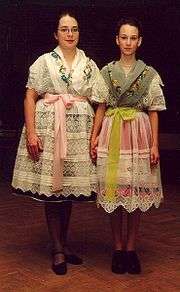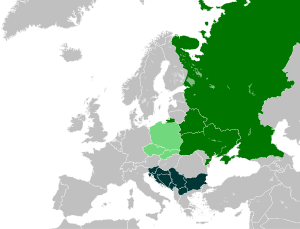Sorbs
|
Sorbian flag, in Pan-Slavic colors, introduced 1842. | |
|
Female traditional costume of Upper Lusatia (Spreewald) | |
| Total population | |
|---|---|
|
(60,000[1]-70,000[2] (est.) • 40,000 Upper Sorbs • 20,000 Lower Sorbs) | |
| Regions with significant populations | |
| 60,000 | |
| 2,000[3] | |
| less than 1,000 | |
| Languages | |
| Sorbian (Upper Sorbian, Lower Sorbian), German | |
| Religion | |
| Majority Roman Catholicism, Lutheranism | |
Sorbs (Upper Sorbian: Serbja; Lower Sorbian: Serby, German: Sorben), known also by their former autonyms Lusatians and Wends, are a West Slavic ethnic group predominantly inhabiting their homeland in Lusatia, a region divided between Germany (the states of Saxony and Brandenburg) and Poland (the provinces of Lower Silesia and Lubusz). They traditionally speak the Sorbian languages (also known as "Wendish" and "Lusatian"), closely related to Czech and Polish.[4] Sorbian is an officially recognized minority language of Germany. The Sorbs are linguistically and genetically closest to Czechs and next-closest to Poles. Due to a gradual and increasing assimilation between the 17th and 20th centuries, virtually all Sorbs also spoke German by the late 19th century and much of the recent generations no longer speak the languages. The community is divided religiously between Roman Catholicism (the majority) and Lutheranism.
Ethnology
The ethnonym "Sorbs" (Serbja, Serby) derives from the medieval tribe, Sorbs (Surbi, Sorabi). The original ethnonym, Srbi, was retained by the Sorbs and Serbs in the Balkans.[5] By the 6th century, Slavs occupied the area west of the Oder formerly inhabited by Germanic peoples.[5] The Sorbs are first mentioned in the 7th century.
In the 19th century the autonym of the Slavic population of Lusatia (the Sorbs) was "Lusatians".[6] The name "Lusatia" was originally applied only to Lower Lusatia, which had been inhabited by Slavs known as Luzici, who may be regarded ancestors of the Lower Sorbs, while Upper Lusatia was inhabited by Slavs known as Milceni, the supposed ancestors of Upper Sorbs.[5]
According to a genetic study published in May 2011, Sorbs show the greatest genetic similarity to Czechs, followed by Poles, consistent with their West Slavic language.[7] They show subtle evidence of genetic isolation but less than Sardinians and French Basques.[7]
Population
Demographic history of the Sorb population since 1700:[8]
| Year | 1700 | 1750 | 1880 | 1900 | 1945 |
|---|---|---|---|---|---|
| Population | 250,000 | 200,000 | 166,000 | 146,000 | 100,000 |
Sorbs are divided into two ethnographical groups:
- Upper Sorbs, who speak Upper Sorbian (about 40,000 people).[9]
- Lower Sorbs, who speak Lower Sorbian (about 20,000 people).[10]
The dialects spoken vary in intelligibility in different areas.
-

Map of approximate Sorb-inhabited area in Germany.
-

Map of area and towns inhabited by Sorbs.
-

Detailed map of Sorb-inhabited area in Germany (in Lower Sorbian).
Medieval heritage
Early Middle Ages
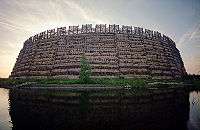
Sorbs arrived in the area extending between the Bober, Kwisa, and Oder rivers to the East and the Saale and Elbe rivers to the West during the 6th century. In the north, the area of their settlement reached Berlin. The earliest surviving mention of the tribe was in 631 A.D., when Fredegar's Chronicle described them as Surbi and as under the rule of a Dervan, an ally of Samo. The Annales Regni Francorum state that in 806 A.D. Sorbian Duke Miliduch fought against the Franks and was killed. In 840, Sorbian Duke Czimislav was killed. In 932, Henry I conquered Lusatia and Milsko. Gero II, Margrave of the Saxon Ostmark, reconquered Lusatia the following year and, in 939, murdered 30 Sorbian princes during a feast. As a result, there were many Sorbian uprisings against German rule. A reconstructed castle, at Raddusch in Lower Lusatia, is the sole physical remnant from this early period.
Lusatian tribes are noted in the work of the Bavarian Geographer. The document contains a list of the tribes in Central-Eastern Europe east of the Elbe and north of the Danube to the Volga rivers to the Black and Caspian Sea most of them of Slavic origin.[11][12] Having settled by the Elbe, Spree and Neisse in the 6th century, Sorbian tribes divided into two main groups, which have taken their names from the characteristics of the area where they had settled. Sorbs living on the swampy broads of the Lower Spree have taken their name from the word marsh. The Milceni (ancestors of Upper Sorbs) settled on fertile soil around Upper Spree, the name derives from the word měl’ (loess soil). The two groups were separated from each other by a wide and uninhabited forest range. The rest of the tribes settled themselves between the Elbe and Saale. Among the many Slavic tribes, the Bavarian Geographer also noted a few Lusatian tribes: Glomacze - Dolomici, Milceni, Chutizi and Sitice.
High and Late Middle Ages
During the reign of Boleslaw I of Poland in 1002-1018, three Polish-German wars were waged which caused Lusatia to come under the domination of new rulers. In 1018, on the strength of peace in Bautzen, Lusatia became a part of Poland; however, it returned to German rule before 1031. From the 11th to the 15th century, agriculture in Lusatia developed and colonization by Frankish, Flemish and Saxon settlers intensified. In 1327 the first prohibitions on using Sorbian in Altenburg, Zwickau and Leipzig appeared.
Modern history
Early modern period
Between 1376 and 1635 Lusatia was part of the Lands of the Bohemian Crown, under the rule of the Luxembourgs. From the beginning of the 16th century the whole Sorbian-inhabited area, with the exception of Lusatia, underwent Germanization. In 1635 Lusatia became a fiefdom of Saxon electors. The Thirty Years' War and the plague of the 17th century caused terrible devastation in Lusatia. This led to further German colonization and Germanization.
In 1667 the Prince of Brandenburg, Frederick Wilhelm, ordered the immediate destruction of all Sorbian printed materials and banned saying masses in this language. At the same time the Evangelical Church supported printing Sorbian religious literature as a means of fighting the Counterreformation. In 1706 the Sorbian Seminary, the main centre for the education of Sorbian Catholic priests, was founded in Prague. Evangelical students of theology formed the Sorbian College of Ministers.
Late modern period
The Congress of Vienna, in 1815, gave part of Upper Lusatia to Saxony, but most of Lusatia to Prussia. More and more bans on the use of Sorbian languages appeared from then until 1835 in Saxony and Prussia; emigration of the Sorbs, mainly to the town of Serbin in Texas and to Australia, increased. In 1848, 5000 Sorbs signed a petition to the Saxon Government, in which they demanded equality for the Sorbian language with the German one in churches, courts, schools and Government departments. From 1871 the whole of Lusatia became a part of united Germany and was divided between two parts; Prussia (Silesia and Brandenburg), and Saxony.
In 1871 the industrialization of the region and German immigration began; official Germanization intensified. Although the Weimar Republic guaranteed constitutional minority rights, it did not practice them.
Contemporary history
Throughout the Third Reich, Sorbians were described as a German tribe who spoke a Slavic language and their national poet Handrij Zejler was German. Sorbian costume, culture, customs, and the language was said to be no indication of a non-German origin. The Reich declared that there were truly no "Sorbs" or "Lusatians", only Wendish-Speaking Germans. As such, the cultivation of "Wendish" customs and traditions was to be encouraged in a controlled manner and the Slavic language would decline due to natural causes. Young Sorbs enlisted in the Wehrmacht and were sent to the front. Entangled lives of the Sorbs during World War II are exemplified by life stories of Mina Witkojc, Měrčin Nowak-Njechorński and Jan Skala.
The first Lusatian cities were captured in April 1945, when the Red Army and the Polish Second Army crossed the river Queis (Kwisa). The defeat of Nazi Germany changed the Sorbs’ situation considerably: those to the east of Neisse and Oder were expelled or assimilated by Poland. The regions in East Germany (the German Democratic Republic) faced a large influx of expelled Germans and heavy industrialisation, which both forced Germanization. The East German authorities tried to counteract this development by creating a broad range of Sorbian institutions. The Sorbs were officially recognized as an ethnic minority, more than 100 Sorbian schools and several academic institutions were founded, the Domowina and its associated societies were re-established and a Sorbian theatre was created. Owing to the oppression of the church and forced collectivization, however, these efforts were severely affected and consequently over time the number of people speaking Sorbian languages decreased by half.
Sorbs caused the communist government of East Germany plenty of trouble, mainly because of the high levels of religious observance and resistance to the nationalisation of agriculture. During the compulsory collectivization campaign, a great many unprecedented incidents were reported. Thus, throughout the Uprising of 1953 in East Germany, violent clashes with the police were reported in Lusatia. An open uprising took place in three upper communes of Błot.
After the reunification of Germany on 3 October 1990, Lusatians made efforts to create an autonomous administrative unit; however Helmut Kohl’s government did not agree to it. After 1989 the Sorbian movement revived; however, it still encounters many obstacles. Although Germany supports national minorities, Sorbs claim that their aspirations are not sufficiently fulfilled. The desire to unite Lusatia in one of the federal states has not been taken into consideration. Upper Lusatia still belongs to Saxony and Lower Lusatia to Brandenburg. Liquidations of Sorbian schools, even in areas mostly populated by Sorbs, still happen, under the pretext of financial difficulties or demolition of whole villages to create lignite quarries.
Faced with growing threat of cultural extinction the Domowina issued a memorandum in March 2008[13] and called for "help and protection against the growing threat of their cultural extinction, since an ongoing conflict between the German government, Saxony and Brandenburg about the financial distribution of help blocks the financing of almost all Sorbian institutions". The memorandum also demands a reorganisation of competence by ceding responsibility from the Länder to the federal government and an expanded legal status. The call has been issued to all governments and heads of state of the European Union.[14]
On 28 May 2008, the Sorbian politician Stanislaw Tillich, member of the governing Christian Democrats, was elected as Minister President of the State of Saxony.
Language and culture
The oldest known relic of Sorbian literature originated in about 1530 - the Bautzen townsmen’s oath. In 1548 Mikołaj Jakubica – Lower Sorbian vicar, from the village called Lubanice, wrote the first unprinted translation of the New Testament into Lower Sorbian.
In 1574 the first Sorbian book was printed: Albin Mollers’ songbook. In 1688 Jurij Hawštyn Swětlik translated the Bible for Catholic Sorbs. From 1706 to 1709 the New Testament was printed in the Upper Sorbian translation was done by Michał Frencel and in Lower Sorbian by Jan Bogumił Fabricius (1681–1741). Jan Bjedrich Fryco (a.k.a. Johann Friedrich Fritze) (1747–1819), translated the Old Testament for the first time into Lower Sorbian, published in 1790.
Other Sorbian Bible translators include Jakub Buk (1825–1895), Michał Hórnik (Michael Hornig) (1833–1894), Jurij Łušćanski (a.k.a. Georg Wuschanski) (1839–1905).
In 1809 for the short period of time, there was the first printed Sorbian newspaper. In 1767 Jurij Mjeń publishes the first secular Sorbian book. Between 1841 and 1843, Jan Arnošt Smoler and Leopold Haupt published two-volume collection of Wendish folk-songs in Upper and Lower Lusatia.
From 1842, the first Sorbian publishing companies started to appear: the poet Handrij Zejler set up a weekly magazine, the precursor of today’s Serbian News. In 1845 in Bautzen the first festival of Sorbian songs took place.
_1982%2C_MiNr_Zusammendruck_2716-2721.jpg)
In 1875, Jakub Bart-Ćišinski, the poet and classicist of Upper Sorbian literature, and Karol Arnošt Muka created a movement of young Sorbians influencing Lusatian art, science and literature for the following 50 years.
Similar movement in Lower Lusatia was organized around the most prominent Lower Lusatian poets Mato Kósyk (Mato Kosyk) and Bogumił Šwjela.
In 1904, mainly thanks to the Sorbs’ contribution, the most important Sorbian cultural centre (the Sorbian House) was built in Bautzen. In 1912, the social and cultural organization of Lusatian Sorbs was created, the Domowina Institution - the union of Sorbian organizations. In 1919 it had 180,000 members. In 1920 Jan Skala set up a Sorbian party and in 1925 in Berlin, Skala started Kulturwille- the newspaper for the protection of national minorities in Germany. In 1920 the Sokol Movement was founded (youth movement and gymnastic organization). From 1933 the Nazi party started to repress the Sorbs. At that time the Nazis also dissolved the Sokol Movement and began to combat every sign of Sorbian culture. In 1937 activities of the Domowina Institution and other organizations were banned as anti-national. Sorbian clergymen and teachers were forcedly deported from Lusatia; Nazi German authorities confiscated the Sorbian House, other buildings and crops.
On May 10, 1945, in Crostwitz, after the Red Army’s invasion, the Domowina Institution renewed its activity. In 1948 Landtag of Saxony passed an Act guaranteeing protection to Sorbian Lusatians; in 1949 Brandenburg resolved a similar law. In the times of the German Democratic Republic, Sorbian organizations were financially supported by the country, but at the same time the authorities encouraged Germanization of Sorbian youth as a means of incorporating them into the system of "building Socialism". Sorbian language and culture could only be publicly presented as long as they promoted socialist ideology.
For over 1000 years the Sorbs were able to maintain and even develop their national culture, despite escalating Germanization and Polonization, mainly due to the high level of religious observance, cultivation of their tradition and strong families (Sorbian families still often have five children).
In the middle of the 20th century, the revival of the Central European nations included some Sorbs, who became strong enough to attempt twice to regain their independence. After World War II, the Lusatian National Committee in Prague claimed the right to self-government and separation from Germany and the creation of a Lusatian Free State or attachment to Czechoslovakia. The majority of the Sorbs were organized in the Domowina, though, and did not wish to split from Germany. Claims asserted by the Lusatian National movement were postulates of joining Lusatia to Poland or Czechoslovakia. Between 1945–1947 they postulated about ten petitions[15] to the United Nations, the United States, Soviet Union, the United Kingdom, France, Poland and Czechoslovakia, however, it did not bring any results. On April 30, 1946, the Lusatian National Committee also postulated a petition to the Polish Government, signed by Pawoł Cyž – the minister and an official Sorbian delegate in Poland. There was also a project of proclaiming a Lusatian Free State, whose Prime Minister was supposed to be a Polish archaeologist of Lusatian origin- Wojciech Kóčka. The most radical postulates in this area (" Na swobodu so ńečeka, swobodu so beŕe!")[16] were expressed by the Lusatian youth organization- Narodny Partyzan Łužica.
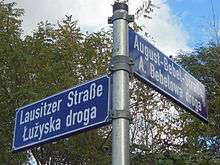
Similarly, in Czechoslovakia, where before the Potsdam Conference in Prague, 300,000 people demonstrated for the independence of Lusatia. The endeavours to separate Lusatia from Germany did not succeed because of various individual and geopolitical interests.
The following statistics indicates the progression of cultural change among Sorbs: by the end of the 19th century, about 150,000 people spoke Sorbian languages. In 1920 almost all Sorbs mastered Sorbian and German to the same degree. Nowadays the number of people using Sorbian languages has been estimated to be no more than 40,000.
Traditions
Zapust is the most popular tradition of the Sorbs, deeply linked to the working life of the community. Traditionally, festivities would last one week ahead of the spring sowing of the fields and would feature traditional dress, parade and dancing.[17]
Egg decorating (pisanici) is a Slavic Easter tradition maintained by Sorbs since the 17th century.[18]
Regions of Lusatia
There are three main regions of Lusatia that differ in language, religion and customs.
Region of Catholic Lusatia

Catholic Lusatia encompasses 85 towns in the districts of Bautzen, Kamenz, and Hoyerswerda, where Upper Sorbian language, customs, and tradition are still thriving. In some of these places (e.g., Radibor or Radwor in Sorbian, Crostwitz or Chrósćicy, and Rosenthal or Róžant), Sorbs constitute the majority of the population, and children grow up speaking Sorbian.
On Sundays, during holidays, and at weddings, people wear regional costumes, rich in decoration and embroidery, encrusted with pearls.
Some of the customs and traditions observed include Bird Wedding (25 January), Easter Cavalcade of Riders, Witch Burning (30 April), Maik, singing on St. Martin's Day (Nicolay), and the celebrations of Saint Barbara’s Day and Saint Nicholas’s Day.
Region of Hoyerswerda (Wojerecy) and Schleife (Slepo)
In the area from Hoyerswerda to Schleife, a dialect of Sorbian which combines characteristic features of both Upper and Lower Sorbian is spoken. The region is predominantly Protestant, highly devastated by the brown coal mining industry, sparsely populated, and to a great extent germanicized. Most speakers of Sorbian are over 60 years old.
The region distinguishes itself through many examples of Slavic wooden architecture monuments including churches and regular houses, a diversity of regional costumes (mainly worn by elderly women) that feature white-knitting with black, cross-like embroidery, and a tradition of playing bagpipes. In several villages, residents uphold traditional festivities such as expelling of winter, Maik, Easter and Great Friday singing, and the celebration of dźěćetko (disguised child or young girl giving Christmas presents).
Region of Lower Lusatia

There are 60 towns from the area of Cottbus belonging to this region, where most of the older people over 60 but few young people and children can speak the Lower Sorbian language; the local variant often incorporates many words taken from the German, and in conversations with the younger generation, German is generally preferred. Some primary schools in the region teach bilingually, and in Cottbus there is an important Gymnasium whose main medium of instruction is Lower Sorbian. The region is predominantly Protestant, again highly devastated by the brown coal mining industry. The biggest tourist attraction of the region and in the whole Lusatia are the marshlands, with many Spreewald/Błóta canals, picturesque broads of the Spree.
Worn mainly by older but on holidays by young women, regional costumes are colourful, including a large headscarf called "lapa", rich in golden embroidering and differing from village to village.
In some villages, following traditions are observed: Shrovetide, Maik, Easter bonfires, Roosters catching/hunting. In Jänschwalde (Sorbian: Janšojcach) so-called Janšojki bog (disguised young girl) gives Christmas presents.
Lusatian anthem
in Lower Sorbian
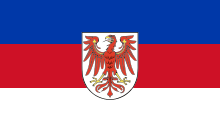
- Rědna Łužyca
- Rědna Łužyca,
- spšawna, pśijazna,
- mojich serbskich woścow kraj,
- mojich glucnych myslow raj,
- swěte su mě twoje strony.
- Cas ty pśichodny,
- zakwiś radostny!
- Och, gab muže stanuli,
- za swoj narod źěłali,
- godne nimjer wobspomnjeśa!
in Upper Sorbian
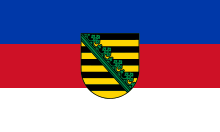
- Rjana Łužica
- Rjana Łužica,
- sprawna přećelna,
- mojich serbskich wótcow kraj,
- mojich zbóžnych sonow raj,
- swjate su mi twoje hona!
- Časo přichodny,
- zakćěj radostny!
- Ow, zo bychu z twojeho
- klina wušli mužojo,
- hódni wěčnoh wopomnjeća!
The Sorbs and Poland

Bolesław I had taken control of the marches of Lusatia (Łużyce), Sorbian Meissen (Miśnia), and the cities of Budziszyn (Bautzen) and Meissen in 1002, and refused to pay the tribute to the Empire from the conquered territories. Bolesław, after the Polish-German War (1002–1018), signed the Peace of Bautzen on 30 January 1018, which made Bolesław I a clear winner. The Polish ruler was able to keep the contested marches of Lusatia and Sorbian Meissennot as fiefs, but as part of Polish territory.[19][20] The Polish prince Mnyachko destroyed a 100 Sorbian villages in 1030 and expelled them from urban areas, exception made of fisherman and carpenters, who were allowed to live in the outskirts.[21]
One of the pioneers of the cooperation between the two nations was Polish historian Wilhelm Bogusławski who lived in the 19th century and wrote the first book on Polish-Sorbian history Rys dziejów serbołużyckich (Polish title), it was published in Saint Petersburg in 1861. The book was expanded and published again in cooperation with Michał Hórnik in 1884 in Bautzen, under a new title Historije serbskeho naroda. Alfons Parczewski was another friend of Sorbs, who from 1875 was involved in Sorbs' rights protection, participating in Sorbian meetings in Bautzen. It was thanks to him, among others, that Józef Ignacy Kraszewski founded a scholarship for Sorbian students. An association of friends of Sorbian Nation was established at the University of Warsaw in 1936 (Polish full name: Towarzystwo Przyjaciół Narodu Serbo-Łużyckiego). It gathered people not only from the university. Its president was Professor Stanisław Słoński, and the deputy president was Julia Wieleżyńska. The association was a legal entity. There were three individual organizations devoted to Sorbian matters. Prołuż founded in Krotoszyn, expanded to all Poland (3000 members). It was the biggest non-communist organization that dealt with foreign affairs. This youth organization was created during the Soviet occupation and its motto was "Polish guard over Lusatia" (pl. Nad Łużycami polska straż). Its highest activity was in Greater Poland (Polish: Wielkopolska, a district of western Poland). After the creation of East Germany, Prołuż was dissolved, and its president historian from Poznań Alojzy Stanisław Matyniak was arrested.[22]
Diaspora
During the 1840s, many Sorbian émigrés travelled to Australia, along with many ethnic Germans. The first was Jan Rychtar, a Wendish Moravian Brethren missionary who settled in Sydney during 1844.[23] There were two major migrations of Upper Sorbs and Lower Sorbs to Australia, in 1848 and 1850 respectively. The diaspora settled mainly in South Australia – especially the Barossa Valley – as well as Victoria and New South Wales.
Many Wends also migrated from Lusatia to the United States, especially Texas.[24]
Possible relationship to Ashkenazi Jews
The Israeli Slavic linguist Paul Wexler has argued that the Yiddish language structure provides "compelling evidence of an intimate Jewish contact with the Slavs in the German and Bohemian lands as early as the 9th century," and has theorized that Sorbs may have been contributors to the Ashkenazic Jewish population in Europe from the same period.[25][26]
See also
- List of Sorbs
- Lusatia
- Polabian Slavs
- Serbs
- Wends
- Milceni
- Pavle Jurišić Šturm
- Wendish People's Party
- Wends of Texas
- List of Medieval Slavic tribes
References
- ↑ Catherine Hickley. Germany's Sorb Minority Fights to Save Villages From Vattenfall. Bloomberg. December 18, 2007.
- ↑ "Sorbs of East Germany". faqs.org. Retrieved 18 March 2015.
- ↑ "Společnost přátel Lužice". luzice.cz. Retrieved 18 March 2015.
- ↑ Helmut Faska. About Sorbian Language. Archived October 6, 2014, at the Wayback Machine.
- 1 2 3 Stone 2015, p. 9.
- ↑ Smedley, Edward (1845). Encyclopædia metropolitana; or, Universal dictionary of knowledge, ed. by E. Smedley, Hugh J. Rose and Henry J. Rose. [With] Plates. p. 777.
- 1 2 Veeramah 2011.
- ↑ Víšek, Zdeněk. "Lužičtí Srbové a česko-lužickosrbské vztahy". Listy (in Czech). Retrieved 29 September 2014.
- ↑ Jana Šołćina, Edward Wornar: Obersorbisch im Selbststudium, Hornjoserbšćina za samostudij. Bautzen: Domowina-Verlag, 2000. Page 10.
- ↑ "Sorben". sachsen.de. Retrieved 18 March 2015.
- ↑ V. von Keltsch, Der bairische Geograph, Alpreussische Monatsschr., 23 (1886),
- ↑ Gerhard Billig, Zur Rekonstruktion der ältesten slawischen Burgbezirke im obersächsisch-meißnischen Raum auf der Grundlage des Bayerischen Geographen, Neues Archiv für sächsische Geschichte 66 (1995), s. 27-67
- ↑ "DOMOWINA - Medijowe wozjewjenje - Pressemitteilung- Press release". sorben.com. Retrieved 18 March 2015.
- ↑ "Kulturhoheit: Sorben bitten Europa um Hilfe - International - Politik - Tagesspiegel". tagesspiegel.de. Retrieved 18 March 2015.
- ↑ Administrator. "Działalność Wojciecha (Wojcecha) Kócki w serbołużyckim ruchu narodowym w latach 1945 - 1950". prolusatia.pl. Retrieved 18 March 2015.
- ↑ Administrator. "Akcja "Narodny Partyzan Łužica" (1946 - 1947) i jej reperkusje w serbołużyckim ruchu narodowym". prolusatia.pl. Retrieved 18 March 2015.
- ↑ Germany's Sorbs celebrate Zapust festival. The local Germany's News in English. March 12, 2010.
- ↑ German Slavic minority cultivates a colorful Easter tradition. Ethiopian Review. March 31, 2010.
- ↑ Jasienica, Pawel (2007) (in Polish). Polska Piastow. Proszynski Media. ISBN 978-83-7648-284-2
- ↑ Bernhardt, John W (1993). Itinerant Kingship and Royal Monasteries in Early Medieval Germany, c. 936–1075. Cambridge University Press. ISBN 0-521-52183-1
- ↑ "Лужички Срби, њихова историја и култура". // rastko.rs. Retrieved 2016-10-24.
- ↑ "Prołuż Akademicki Związek Przyjaciół Łużyc" Jakub Brodacki. Polska Grupa Marketingowa 2006 ISBN 83-60151-00-8
- ↑ Nielsen. Georg, R. In Search of a Home,(1977); Birmingham Slavonic Monographs. ISBN 0 70440236 X.
- ↑ "Texas Wendish Heritage". Texas Wendish Heritage. Retrieved 18 March 2015.
- ↑ Paul Wexler, The Ashkenazic Jews, Slavica Publishers, 1993
- ↑ Paul Wexler (1992), "From Serb Lands to Sorb Lands," in The Balkan Substratum of Yiddish: A Reassessment of the Unique Romance and Greek Components, Harrassowitz Verlag, 1992, p. 111
Sources
- Stone, Gerald (2015). The Smallest Slavonic Nation: The Sorbs of Lusatia. Bloomsbury Publishing. ISBN 978-1-4742-4154-0.
- Veeramah et al. (2011). "Genetic variation in the Sorbs of eastern Germany in the context of broader European genetic diversity". European Journal of Human Genetics. 19: 995–1001. doi:10.1038/ejhg.2011.65.
- Žura, Slavica Vrkić (2011). "Lužički Srbi – Najmanji slavenski narod". Ethnologica Dalmatica. 18 (1): 93–130. (Croatian)
Bibliography
- Filip Gańczak Mniejszość w czasach popkultury, Newsweek, nr 22/2007, 03.06.2007.
- W kręgu Krabata. Szkice o Juriju Brězanie, literaturze, kulturze i językach łużyckich, pod red. J.Zarka, Wydawnictwo Uniwersytetu Śląskiego, Katowice, 2002.
- Mirosław Cygański, Rafał Leszczyński Zarys dziejów narodowościowych Łużyczan PIN, Instytut Śląski, Opole 1997.
- Die Sorben in Deutschland, pod red. M.Schiemann, Stiftung für das sorbische Volk, Görlitz 1997.
- Mały informator o Serbołużyczanach w Niemczech, pod red. J.Pětrowej, Załožba za serbski lud, 1997.
- Dolnoserbske nałogi/Obyczaje Dolnych Łużyc, pod red. M.Stock, Załožba za serbski lud, 1997.
- "Rys dziejów serbołużyckich" Wilhelm Bogusławski Piotrogród 1861
- "Prołuż Akademicki Związek Przyjaciół Łużyc" Jakub Brodacki. Polska Grupa Marketingowa 2006 ISBN 83-60151-00-8.
- "Polska wobec Łużyc w drugiej połowie XX wieku. Wybrane problemy", Mieczkowska Małgorzata, Szczecin 2006 ISBN 83-7241-487-4.
- "A Rock Against Alien Waves: A History of the Wends". Charles Wukasch. Austin: Concordia University Press, 2004.
- "Sorbs," David Zersen, in Germans and the Americas: Culture, Politics and History, 3 vols., edited by Thomas Adam. ABC-CLIO, 2005.
External links
 "Sorbs". Encyclopædia Britannica. 25 (11th ed.). 1911.
"Sorbs". Encyclopædia Britannica. 25 (11th ed.). 1911.- The Domowina Institution
- SERBSKE NOWINY - Sorbian Newspaper
- SERBSKI INSTITUT - Sorbian history and culture
- - independent Sorbian internet magazine
- Wikipedia in Upper Sorbian (hsb)
- Sorbian emigration into Australia
- Project Rastko - Lusatia, Electronic Library of Sorbian-Serbian Ties
- Texas Wendish Heritage Society
- Wendish Heritage Society of Australia
| Wikimedia Commons has media related to Sorbs. |

